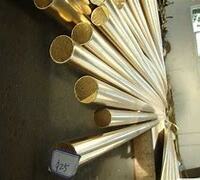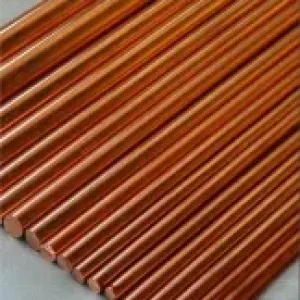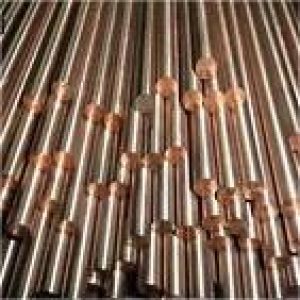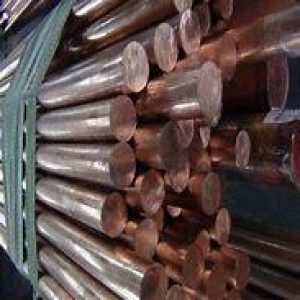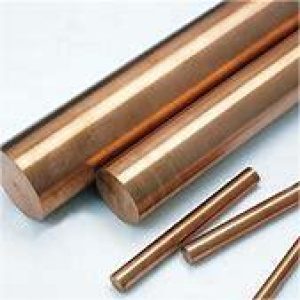Overview of Copper Earthing Rod
Copper rods are cylindrical or near-cylindrical shapes made from pure copper or copper alloys. Known for their excellent electrical and thermal conductivity, malleability, and resistance to corrosion, copper rods find wide application across various industries. These rods can be produced through several processes, including casting, extrusion, or continuous casting, and can be supplied in different sizes, lengths, and tempers (soft, half-hard, hard) to meet specific application requirements.
Features of Copper Earthing Rod
-
High Conductivity: Copper is a superior conductor of both electricity and heat, making it ideal for electrical wiring, heat exchangers, and cookware.
-
Corrosion Resistance: Copper forms a protective oxide layer when exposed to the atmosphere, which prevents further corrosion, ensuring longevity in harsh environments.
-
Malleability and Ductility: Copper rods can be easily formed, bent, or shaped without fracturing, allowing for versatile fabrication processes.
-
Recyclability: Copper is highly recyclable, with no degradation in performance, contributing to sustainability efforts.
-
Wide Range of Alloys: Copper can be combined with other metals like tin, zinc, aluminum, or nickel to form alloys like brass, bronze, or cupronickel, enhancing specific properties such as strength, hardness, or resistance to specific corrosive media.
Applications of Copper Earthing Rod
-
Electrical Industry: Copper rods are widely used in electrical cables, transformers, and busbars due to their high conductivity.
-
Construction: Used for plumbing, roofing, and electrical installations in buildings due to its durability and resistance to corrosion.
-
Heat Exchangers: In HVAC systems, refrigeration units, and industrial heat exchange applications because of copper’s efficient heat transfer properties.
-
Manufacturing and Machining: Copper rods serve as raw material for producing various components in machinery, automotive parts, and hardware.
-
Cookware and Utensils: Due to its heat conductivity and non-reactive nature, copper is used in high-end cookware and kitchen utensils.
-
Jewelry Making: Pure copper or copper alloys are used in jewelry creation for their aesthetic appeal and workability.
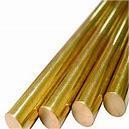
(Copper Earthing Rod)
Parameters of Copper Earthing Rod
The copper earthing rod parameter is a measurement of the length and pitch of the wire used in an earthing system. It is typically measured using an earthing cable or kit and can range from a few inches to several feet.
There are different types of copper earthing rods that are commonly used in earthing systems. Some common types include:
1. Round Earthing Rod: This type of rod has a round shape and measures about 5-7 inches in diameter. It has a slightly larger pitch than other types of earsystem rods.
2.earthing Rod: This type of rod has a slightly smaller shape than a round earthing rod and measures around 4-6 inches in diameter. It has a smaller pitch than other types of earsystem rods.
3. Pointed Earthing Rod: This type of rod has a pointed shape and measures about 5-7 inches in diameter. It has a larger pitch than other types of earsystem rods.
4. Square Earthing Rod: This type of rod has a square shape and measures around 4-6 inches in diameter. It has a larger pitch than other types of earsystem rods.
5. Notch Earthing Rod: This type of rod has a concave shape and measures around 4-6 inches in diameter. It has a smaller pitch than other types of earsystem rods.
The parameters for each type of copper earthing rod depend on the specific design of the system being used. For example, if the system uses a round earthing rod, it may be necessary to specify its pitch. If the system uses aearthing rod, it may be necessary to specify its size and length. If the system uses a pointed earthing rod, it may be necessary to specify its pitch and length. Finally, if the system uses a square earthing rod, it may be necessary to specify its pitch and size.
In general, the range of values for the copper earthing rod parameter can vary depending on the design of the system being used. It is recommended to consult with a professional who is experienced in the use of copper earthing rods to determine the best value for your specific application.
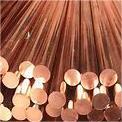
(Copper Earthing Rod)
Company Profile
Copper Channel is a trusted global metal material supplier & manufacturer with over 12-year-experience in providing super high-quality copper products and relatives products.
The company has a professional technical department and Quality Supervision Department, a well-equipped laboratory, and equipped with advanced testing equipment and after-sales customer service center.
If you are looking for high-quality copper materials and relative products, please feel free to contact us or click on the needed products to send an inquiry.
Payment Methods
L/C, T/T, Western Union, Paypal, Credit Card etc.
Shipment
It could be shipped by sea, by air, or by reveal ASAP as soon as repayment receipt.
FAQs of Copper Earthing Rod
Q: What are the common sizes of Copper Earthing Rod available?
A: Copper Earthing Rod is typically available in diameters ranging from 1/8 inch to several inches and lengths up to several meters, depending on the manufacturer and application requirements.
Q: Is Copper Earthing Rod suitable for outdoor use?
A: Yes, copper’s natural corrosion resistance makes it suitable for outdoor applications where exposure to weather elements is expected.
Q: Can Copper Earthing Rod be welded or soldered?
A: Yes, Copper Earthing Rod can be easily welded and soldered using appropriate techniques and materials, making them suitable for complex assemblies.
Q: How does the cost of Copper Earthing Rod compare to other conductive materials?
A: While copper is more expensive than some other metals, its superior conductivity and long-term reliability often justify the cost, especially in electrical applications where efficiency is crucial.
Q: Are there any environmental concerns with using Copper Earthing Rod?
A: Copper is considered an environmentally friendly material due to its high recyclability and low toxicity. However, proper disposal of copper products should still follow environmental guidelines to prevent pollution.
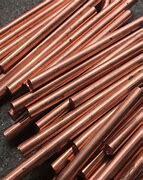
(Copper Earthing Rod)
